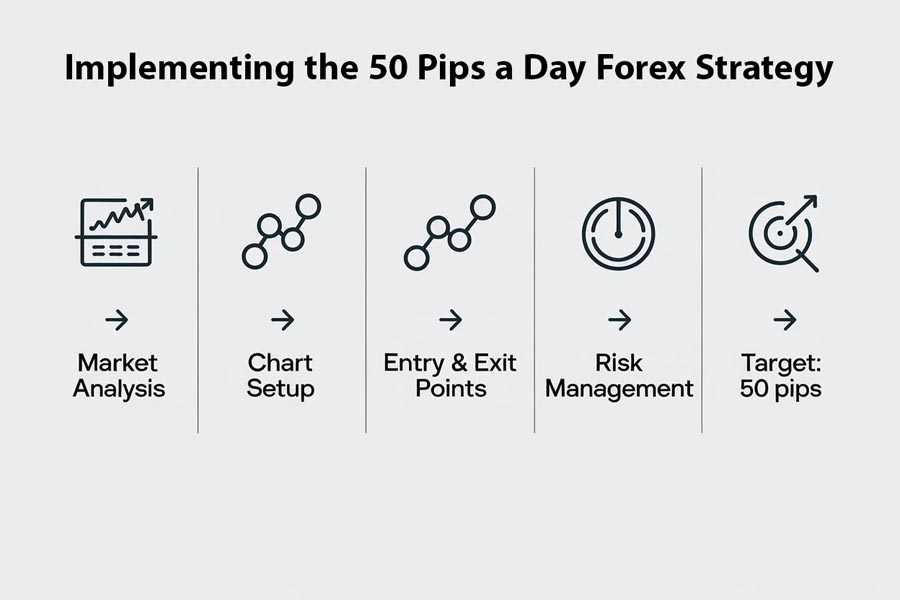Are you ready to transform your forex trading results? The 50 pips a day forex trading strategy is your answer to achieving consistent profits in the unpredictable world of currency trading. This robust approach focuses on setting a daily target of 50 pips, allowing traders to effectively manage risk while maximizing their chances of success. Whether you’re a novice or an experienced trader looking to refine your skills, this strategy provides a structured framework that can lead to impressive results. To implement this strategy effectively, it’s crucial to select a reliable online forex broker that suits your trading style and needs.

In this comprehensive guide, we’ll explore the ins and outs of the 50 pips a day forex strategy, detailing essential techniques and considerations that can help you unlock your trading potential. Get ready to dive deep into the mechanics of this powerful strategy and learn how to navigate the forex market with confidence.
Understanding the 50 Pips a Day Forex Trading Strategy
What Are Pips in Forex Trading?

Before we delve deeper into the strategy, it’s essential to understand what pips are in forex trading. A pip, short for “percentage in point,” represents the smallest price movement in currency exchange rates. For most currency pairs, a pip equals 0.0001 of the quoted price. For instance, if the EUR/USD moves from 1.1000 to 1.1001, that’s a one-pip movement. Understanding pips is vital, as they directly relate to your profit and loss calculations.
The Concept Behind the Strategy
The 50 pips a day forex trading strategy revolves around setting a clear and achievable daily profit target of 50 pips. This approach aims to:
- Provide a clear, achievable goal: A specific target helps maintain focus and discipline.
- Limit risk exposure: By targeting a fixed number of pips, traders can manage their risk more effectively.
- Encourage disciplined trading: A defined target promotes adherence to a trading plan, reducing emotional decision-making.
- Capitalize on daily market movements: The forex market is inherently volatile, often providing numerous opportunities to achieve the 50-pip target.
By concentrating on a specific target, traders can avoid the common pitfalls of overtrading and emotional decision-making that frequently lead to losses.
Read More: 20 Pips a Day Scalping Forex Trading Strategy
The Theory Behind the 50 Pips a Day Strategy
The 50 pips a day forex strategy is grounded in the continuous flow of money around the globe in the currency markets, which operate 24 hours a day, five days a week. This strategy capitalizes on the transitions between major trading sessions—London, European, U.S., and Asian—by targeting the dominant currency pair for each session.
Key points to understand:
- Daily Movements: There are typically at least 50 pips of tradable movement every day, especially on British Pound crosses.
- Time Windows: The strategy focuses on a 1-2 hour window each day, based on the high and low of the previous day and the week.
- Quick Profits: It’s designed for rapid profits, with trades usually moving into profit quickly if executed correctly.
- Market Psychology: The approach leverages the psychology of market movements, understanding how price breaks highs and lows trigger orders and stop losses.
Implementing the 50 Pips a Day Forex Strategy

Implementing the 50 pips a day forex trading strategy involves several key steps, each requiring careful consideration and execution. Here’s a detailed breakdown:
Step 1: Choose Your Currency Pairs
Selecting the right currency pairs is crucial for the success of this strategy. While it can be applied to various pairs, it’s particularly effective with British Pound crosses due to their consistent movement and tight spreads. Consider these pairs:
- GBP/AUD: Known for its volatility, this pair often provides significant movement.
- GBP/USD: One of the most traded currency pairs in the world, it typically has tight spreads and high liquidity.
- GBP/JPY: The Japanese Yen often exhibits larger price swings, aiding in achieving the 50-pip target.
- GBP/NZD: Although it has wider spreads, it can be more volatile, offering potential for larger moves.
- GBP/CAD and GBP/CHF: These pairs may have less movement but can still provide explosive opportunities under certain conditions.
Step 2: Determine Your Trading Hours
Focus on three key time windows:
- Asian session: 8 PM to 11 PM (New York Eastern Standard Time)
- London session: 2 AM to 5 AM (EST)
- New York session: 8 AM to 11 AM (EST)
These 12 candles (on a 15-minute chart) represent the core trading window for this strategy. Understanding market dynamics during these sessions is essential, as volatility often increases, providing more opportunities for price movement.
Step 3: Set Up Your Charts
Use 15-minute charts for your chosen currency pairs. Set your chart time to New York time for consistency. Here’s how to set up your charts effectively:
- Technical Indicators: While primarily relying on price action, consider using a few technical indicators, such as moving averages, to identify trends and potential entry points.
- Chart Patterns: Familiarize yourself with common chart patterns that may indicate potential reversals or continuations in price movement.
- Clean Layout: Ensure your charts are not cluttered with too many indicators. A clean layout allows you to focus on price action and key levels.
Step 4: Identify Key Levels
Focus on two primary levels:
- Previous day’s high and low: These levels often act as psychological barriers for traders.
- Current week’s high and low: Identifying these levels can help gauge overall market sentiment and potential breakout points.
Draw these levels on your chart as horizontal lines. This visual representation will help you quickly identify potential entry and exit points.
Step 5: Wait for Price Action at Key Levels
Look for price to reach the previous day’s high or low during one of the key time windows. This is where potential trade setups occur. Here’s how to analyze price action effectively:
- Candlestick Patterns: Pay attention to candlestick patterns that form near these key levels. Patterns like engulfing candles and pin bars can indicate strong buying or selling pressure.
- Volume Analysis: While price action is crucial, consider the volume behind the moves. Higher volume often confirms the strength of a move.
- Market Sentiment: Be aware of the overall market sentiment. If the market is bullish, a breakout above the previous day’s high may provide a strong buying opportunity.
Step 6: Enter the Trade
Enter trades based on price action confirmations at these key levels. Look for:
- Engulfing Patterns: These indicate a potential reversal and are often seen at key levels.
- Pin Bars (Hammer Candles): These suggest rejection of a price level and can signal a potential entry point.
When entering a trade, ensure that you have a clear plan for your entry point, stop loss, and take profit levels.
Step 7: Set Your Take Profit and Stop Loss
- Aim for a 50 pip profit target: This is your primary goal for each trade.
- Place your stop loss: Set your stop loss based on the structure of the setup, typically beyond the recent swing high/low. This helps protect your capital in case the market moves against you.
Read More: 100 Pips a Day Trading Strategy
Risk Management
Risk management is a crucial component of the 50 pips a day forex strategy. Here are key principles to follow:
- Risk-to-Reward Ratio: Aim for a minimum risk-to-reward ratio of 1:2. This means if you’re risking 25 pips on a trade, your target should be at least 50 pips.
- Position Sizing: Determine the size of your position based on your account size and risk tolerance. Never risk more than 1-2% of your trading capital on a single trade.
- Adjusting Stop Losses: As trades move in your favor, consider adjusting your stop loss to lock in profits and minimize potential losses.
Advanced Techniques for the 50 Pips a Day Strategy

Understanding Market Structure
- Daily Structure: Recognize when the market is in a trading range (box) or trending. Trade in the direction of the underlying move. Understanding the overall trend can help you make more informed trading decisions.
- Weekly Structure: Understand the concept of “climbing the stairs”—higher lows in an uptrend and lower highs in a downtrend. This helps identify continuation patterns.
- Narrow Range Days: Identify compression days (narrow range bars on the daily chart) as potential precursors to large moves. These days often precede significant breakouts.
Recognizing Key Market Behaviors
Markets typically do three things:
- Trend (break out, pull back, and continue): Identifying the trend can help you align your trades with the market direction.
- False break and reverse: Be cautious of false breakouts, as they can trap traders and lead to losses.
- Hit highs and lows, moving back and forth in a trading range: Understanding this behavior can help you identify potential reversal points.
Recognizing these behaviors helps in predicting potential moves and identifying traps.
Adapting to Different Market Conditions
- Trending Days: These can offer opportunities for larger than 50 pip moves. The market may trend all day without significant pullbacks. In such cases, consider trailing your stop loss to maximize profits.
- Range Days: Focus on trading from one side of the range to the other. Look for opportunities to buy near the bottom of the range and sell near the top.
- Reversal Days: Look for false breaks of previous highs or lows followed by strong moves in the opposite direction. These can provide excellent trading opportunities if identified correctly.
Common Pitfalls to Avoid
- Overtrading: Stick to the key time windows and setups. Don’t feel compelled to trade every session or pair. Quality over quantity is essential in trading.
- Ignoring Market Structure: Always consider the bigger picture—daily and weekly trends. This helps you avoid trading against the overall market direction.
- Chasing Moves: Enter trades at key levels with confirmation, not in the middle of strong moves. This can lead to poor risk-to-reward ratios and increased losses.
- Holding Losers: If a trade doesn’t move quickly into profit, consider exiting rather than letting it hit your stop loss. Developing the discipline to cut losses is crucial for long-term success.
Psychological Aspects of the 50 Pips a Day Strategy

Developing the right mindset is crucial for success with this strategy. Key psychological factors to consider include:
- Patience: Wait for price to reach key levels during the specific time windows. Rushing into trades can lead to mistakes.
- Discipline: Stick to your trading plan and risk management rules. Consistency is key to achieving long-term results.
- Quick Decision Making: Be prepared to enter and exit trades swiftly based on price action. The forex market moves quickly, and hesitation can lead to missed opportunities.
- Emotional Control: Understand that not every trade will be successful. Focus on consistent execution rather than individual trade outcomes. Maintaining a positive mindset can help you stay focused on your long-term goals.
Tracking and Analyzing Your Results
Keep a detailed trading journal to track your progress and identify areas for improvement. Record the following information for each trade:
- Entry and exit points: Document the price levels at which you entered and exited the trade.
- Time of trade and which session: Note the time and session during which the trade was executed.
- Key levels that influenced the trade decision: Identify the technical levels that played a role in your decision-making process.
- Price action patterns observed: Record any patterns that helped you make your trading decisions.
- Profit or loss: Track the outcome of each trade to evaluate your overall performance.
- Any deviations from the strategy: Note any instances where you deviated from your trading plan and the outcomes of those trades.
Regularly review your journal to refine your approach and improve your overall performance. Analyzing your trades helps you identify strengths and weaknesses in your strategy, allowing for continuous improvement.
Why OpoFinance is the Best Choice for Forex Traders
When implementing advanced trading strategies like the 50 Pips a Day strategy, having a reliable and regulated broker is essential for success. OpoFinance, regulated by ASIC, offers an exceptional trading environment designed for both beginners and seasoned traders. Here’s why OpoFinance stands out:
- Tight Spreads & Fast Execution: Achieving 50 pips requires quick and accurate execution. OpoFinance delivers with competitive spreads and ultra-fast order processing.
- Social Trading Platform: Want to learn from experienced traders or share your success? OpoFinance’s social trading feature lets you connect with top traders, observe their strategies, and even copy trades, making it easier for you to master advanced techniques.
- Security & Trust: Being regulated by ASIC means OpoFinance adheres to the highest standards of financial safety, so you can focus on trading with peace of mind.

By choosing OpoFinance, you’re partnering with a broker that aligns with your trading goals, providing you with the tools and support to maximize your success in the forex market. Start your trading journey today with a trusted, innovative broker that puts you first.
Conclusion
The 50 pips a day forex trading strategy offers a structured approach to achieving consistent profits in the forex market. By focusing on key time windows, specific currency pairs, and clear price action signals at important levels, traders can potentially improve their performance and build long-term success. Remember that mastering this strategy requires patience, practice, and continuous learning. Stay committed to your trading plan, adapt to changing market conditions, and always prioritize risk management. With dedication and the right mindset, you can unlock your forex trading potential and work towards achieving your financial goals.
Can the 50 pips a day strategy be applied to all currency pairs?
While the 50 pips a day forex strategy can theoretically be applied to any currency pair, it’s most effective with pairs that exhibit sufficient daily volatility and have tight spreads. British Pound crosses, particularly GBP/AUD, GBP/USD, and GBP/JPY, are often ideal for this strategy due to their consistent daily movement. However, it’s essential to research and test the strategy on different pairs to find those that work best for your trading style and market conditions.
How long does it typically take to become proficient in the 50 pips a day forex strategy?
The time it takes to become proficient in the 50 pips a day forex trading strategy varies from trader to trader. Generally, it can take several months to a year of consistent practice and study to develop the skills and discipline required for successful implementation. Factors that influence the learning curve include your prior trading experience, dedication to learning, and ability to adapt to market conditions. It’s crucial to practice in a demo account before trading live and to continuously refine your approach based on your results and market analysis.
How does the strategy handle major news events and economic releases?
The 50 pips a day forex strategy primarily focuses on price action and key levels, but it’s important to be aware of major news events and economic releases. These events can cause significant volatility and potentially larger-than-usual moves. Some traders using this strategy prefer to avoid trading during major news releases due to the increased risk and unpredictability. Others may see these events as opportunities for larger moves but adjust their risk management accordingly. It’s crucial to have a clear plan for how you’ll handle these events, whether it’s staying out of the market, adjusting your targets, or capitalizing on the increased volatility with strict risk management.







